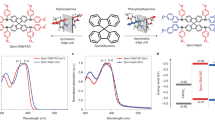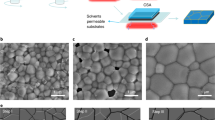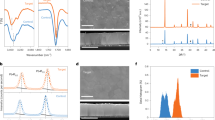Abstract
Perovskite solar cells (PSCs) require both high efficiency and good long-term stability if they are to be commercialized. It is crucial to finely optimize the energy level matching between the perovskites and hole-transporting materials to achieve better performance. Here, we synthesize a fluorene-terminated hole-transporting material with a fine-tuned energy level and a high glass transition temperature to ensure highly efficient and thermally stable PSCs. We use this material to fabricate photovoltaic devices with 23.2% efficiency (under reverse scanning) with a steady-state efficiency of 22.85% for small-area (~0.094 cm2) cells and 21.7% efficiency (under reverse scanning) for large-area (~1 cm2) cells. We also achieve certified efficiencies of 22.6% (small-area cells, ~0.094 cm2) and 20.9% (large-area, ~1 cm2). The resultant device shows better thermal stability than the device with spiro-OMeTAD, maintaining almost 95% of its initial performance for more than 500 h after thermal annealing at 60 °C.
This is a preview of subscription content, access via your institution
Access options
Access Nature and 54 other Nature Portfolio journals
Get Nature+, our best-value online-access subscription
$29.99 / 30 days
cancel any time
Subscribe to this journal
Receive 12 digital issues and online access to articles
$119.00 per year
only $9.92 per issue
Buy this article
- Purchase on Springer Link
- Instant access to full article PDF
Prices may be subject to local taxes which are calculated during checkout




Similar content being viewed by others
References
Stranks, S. D. et al. Electron-hole diffusion lengths exceeding 1 micrometer in an organometal trihalide perovskite absorber. Science 342, 341–344 (2013).
Zhao, Y. & Zhu, K. Organic-inorganic hybrid lead halide perovskites for optoelectronic and electronic applications. Chem. Soc. Rev. 45, 655–689 (2016).
Xing, G. et al. Long-range balanced electron- and hole-transport lengths in organic–inorganic CH3NH3PbI3. Science 342, 344–347 (2013).
Snaith, H. J. Perovskites: The emergence of a new era for low-cost, high-efficiency solar cells. J. Phys. Chem. Lett. 4, 3623–3630 (2013).
Park, N.-G., Grätzel, M., Miyasaka, T., Zhu, K. & Emery, K. Towards stable and commercially available perovskite solar cells. Nat. Energy 1, 16152 (2016).
Jeon, N. J. et al. Solvent engineering for high-performance inorganic–organic hybrid perovskite solar cells. Nat. Mater. 13, 897–903 (2014).
Jeon, N. J. et al. Compositional engineering of perovskite materials for high-performance solar cells. Nature 517, 476–480 (2015).
Yang, W. S. et al. High-performance photovoltaic perovskite layers fabricated through intramolecular exchange. Science 348, 1234–1237 (2015).
Yang, W. S. et al. Iodide management in formamidinium–lead-halide-based perovskite layers for efficient solar cells. Science 356, 1376–1379 (2017).
Best Research-Cell Efficiencies (NREL, 2016); https://www.nrel.gov/pv/assets/images/efficiency-chart.png.
Wang, Z. et al. Efficient ambient-air-stable solar cells with 2D–3D heterostructured butylammonium-caesium-formamidinium lead halide perovskites. Nat. Energy 2, 17135 (2017).
Saliba, M. et al. Cesium-containing triple cation perovskite solar cells: improved stability, reproducibility and high efficiency. Energy Environ. Sci. 9, 1989–1997 (2016).
Grätzel, M. The rise of highly efficient and stable perovskite solar cells. Acc. Chem. Res. 50, 487–491 (2017).
Rehman, W. et al. Photovoltaic mixed-cation lead mixed-halide perovskites: links between crystallinity, photo-stability and electronic properties. Energy Environ. Sci. 10, 361–369 (2017).
Saliba, M. et al. Incorporation of rubidium cations into perovskite solar cells improves photovoltaic performance. Science 354, 206–209 (2016).
Shao, Y., Xiao, Z., Bi, C., Yuan, Y. & Huang, J. Origin and elimination of photocurrent hysteresis by fullerene passivation in CH3NH3PbI3 planar heterojunction solar cells. Nat. Commun. 5, 5784 (2014).
Nie, W. et al. High-efficiency solution-processed perovskite solar cells with millimeter-scale grains. Science 347, 522–525 (2015).
Son, D.-Y. et al. Self-formed grain boundary healing layer for highly efficient CH3NH3PbI3 perovskite solar cells. Nat. Energy 1, 16081 (2016).
Tsai, H. et al. High-efficiency two-dimensional Ruddlesden–Popper perovskite solar cells. Nature 536, 312–316 (2016).
Polander, L. E. et al. Hole-transport material variation in fully vacuum deposited perovskite solar cells. APL Mater. 2, 081503 (2014).
Arora, N. et al. High open-circuit voltage: Fabrication of formamidinium lead bromide perovskite solar cells using fluorene–dithiophene derivatives as hole-transporting materials. ACS Energy Lett. 1, 107–112 (2016).
Chen, H. et al. Molecular engineered hole-extraction materials to enable dopant-free, efficient p-i-n perovskite solar cells. Adv. Energy Mater. 7, 1700012 (2017).
Saliba, M. et al. A molecularly engineered hole-transporting material for efficient perovskite solar cells. Nat. Energy 1, 15017 (2016).
Bi, D. et al. Facile synthesized organic hole transporting material for perovskite solar cell with efficiency of 19.8%. Nano Energy 23, 138–144 (2016).
Xu, B. et al. Tailor-making low-cost spiro[fluorene-9,9′-xanthene]-based 3D oligomers for perovskite solar cells. Chem 2, 676–687 (2017).
Malinauskas, T. et al. Branched methoxydiphenylamine-substituted fluorene derivatives as hole transporting materials for high-performance perovskite solar cells. Energy Environ. Sci. 9, 1681–1686 (2016).
Kim, G.-W., Lee, J., Kang, G., Kim, T. & Park, T. Donor–acceptor type dopant-free, polymeric hole transport material for planar perovskite solar cells (19.8%). Adv. Energy Mater. 8, 1701935 (2018).
Hawash, Z., Ono, L. K. & Qi, Y. Photovoltaics: Recent advances in spiro-MeOTAD hole transport material and its applications in organic–inorganic halide perovskite solar cells. Adv. Mater. Interfaces 5, 1700623 (2018).
Zhao, X. & Wang, M. Organic hole-transporting materials for efficient perovskite solar cells. Mater. Today Energy 7, 208–220 (2017).
Cho, I. et al. Indolo[3,2-b]indole-based crystalline hole-transporting material for highly efficient perovskite solar cells. Chem. Sci. 8, 734–741 (2017).
Zhao, X., Kim, H.-S., Seo, J.-Y. & Park, N.-G. Effect of selective contacts on the thermal stability of perovskite solar cells. ACS Appl. Mater. Interfaces 9, 7148–7153 (2017).
Malinauskas, T. et al. Enhancing thermal stability and lifetime of solid-state dye-sensitized solar cells via molecular engineering of the hole-transporting material Spiro-OMeTAD. ACS Appl. Mater. Interfaces 7, 11107–11116 (2015).
Jeon, N. J. et al. o-Methoxy substituents in spiro-OMeTAD for efficient inorganic–organic hybrid perovskite solar cells. J. Am. Chem. Soc. 136, 7837–7840 (2014).
Hu, Z. et al. Effects of heteroatom substitution in spiro-bifluorene hole transport materials. Chem. Sci. 7, 5007–5012 (2016).
Komino, T., Nomura, H., Yahiro, M. & Adachi, C. Real-time measurement of molecular orientational randomization dynamics during annealing treatments by in-situ ellipsometry. J. Phys. Chem. C. 116, 11584–11588 (2012).
Acknowledgements
This work was supported by a grant from the Korea Research Institute of Chemical Technology (KRICT), Republic of Korea (KK1802-A01), the Korea Institute of Energy Technology Evaluation and Planning (KETEP) and the Ministry of Trade Industry & Energy (MOTIE) of the Republic of Korea (No. 20163010012470), and by a grant from the National Research Foundation of Korea (NRF) funded by the Ministry of Science, ICT & Future Planning (MSIP) of Korea (NRF-2016M3A6A7945503). This research was also supported by the Basic Science Research Program through the National Research Foundation of Korea (NRF) funded by the Ministry of Education (NRF-2015R1A6A3A04058164).
Author information
Authors and Affiliations
Contributions
J.S. and J.L. conceived and supervised the project. N.J.J., E.H.J., S.I.S., J.S. and J.L. wrote the paper. N.J.J. and E.H.J. fabricated and characterized the perovskite solar cells. N.J.J., E.H.J. and J.S. achieved the certified performance of devices at Newport Corporation. H.N. synthesized the relevant materials. H.N. and Y.G.L. performed analysis of the intrinsic properties of the materials via DFT calculation, ultraviolet–visible absorption, CV, TGA, DSC and SCLC measurements. N.J.J. and E.H.J. carried out SEM measurements. T.Y.Y. and H.W.S. analysed charge recombination lifetimes via transient photovoltage measurements as a function of the bias light intensity. G.K. performed TRPL measurements. All authors discussed the results.
Corresponding authors
Ethics declarations
Competing interests
The authors declare no competing interests.
Additional information
Publisher’s note: Springer Nature remains neutral with regard to jurisdictional claims in published maps and institutional affiliations.
Supplementary information
Supplementary Information
Supplementary Figures 1–21 and Supplementary Table 1
Rights and permissions
About this article
Cite this article
Jeon, N.J., Na, H., Jung, E.H. et al. A fluorene-terminated hole-transporting material for highly efficient and stable perovskite solar cells. Nat Energy 3, 682–689 (2018). https://doi.org/10.1038/s41560-018-0200-6
Received:
Accepted:
Published:
Issue Date:
DOI: https://doi.org/10.1038/s41560-018-0200-6
This article is cited by
-
Antimony doped CsPbI2Br for high-stability all-inorganic perovskite solar cells
Nano Research (2024)
-
Numerical and experimental study of transparent electrode effect for charge transport layer-free perovskite solar cells
Optical and Quantum Electronics (2024)
-
Multifunctional dual-anion compensation of amphoteric glycine hydrochloride enabled highly stable perovskite solar cells with prolonged carrier lifetime
Nano Research (2024)
-
Unveiling the surface-interface properties of perovskite crystals and pivotal regulation strategies
Nano Research (2024)
-
Reduction of bulk and surface defects in inverted methylammonium- and bromide-free formamidinium perovskite solar cells
Nature Energy (2023)



